![]()
In the spring of 2023, I received a phone call from Peter Blackberg (an old friend, RIT alumnus, and a space enthusiast) when he asked if I would join a call with NASA astronaut Don Pettit. Don wanted to build a star tracker for his next space flight.
Star trackers— siderial camera mounts — are commonly used for astrophotography to capture the night sky in sharp detail. By rotating at the exact speed the Earth rotates, siderial mounts act to cancel out the motion of the Earth so a camera can keep a fixed position on a star and collect light over time, to reveal even dim and distant stars.
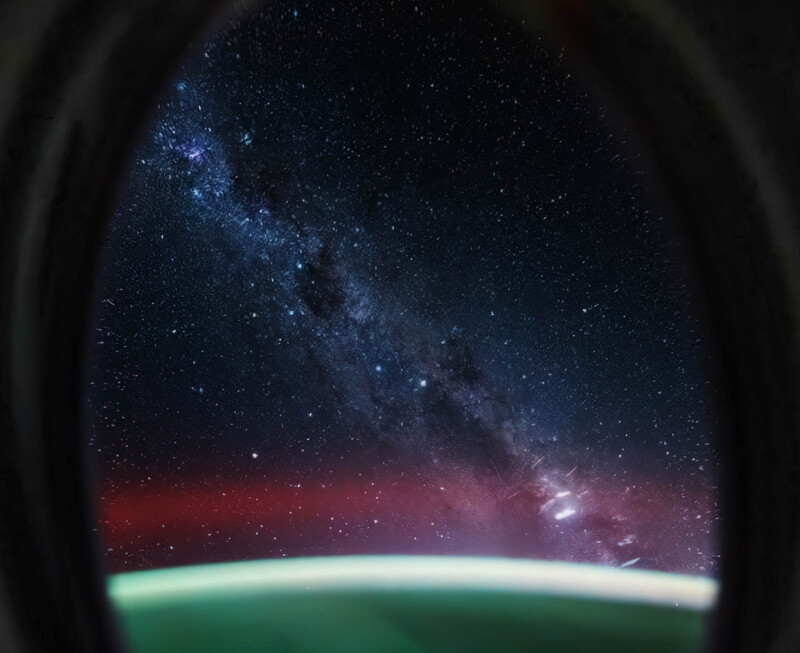 Our galaxy the Milky Way photographed by a special ISS star tracker. Exposure time around 15 seconds. NASA image by astronaut Don Pettit.
Our galaxy the Milky Way photographed by a special ISS star tracker. Exposure time around 15 seconds. NASA image by astronaut Don Pettit.Don wanted to take advantage of the view above our atmosphere of the stars. As the ISS constantly rotates to keep oriented toward the Earth, long exposures nearly all show stars as arced lines. Space telescopes are designed to take research-quality images of astronomical objects (Hubble Space Telescope and recently the James Webb Telescope). Don wanted to share his vision of the cosmos— as a visitor to space looking out the window with the Earth prominent in the photograph.
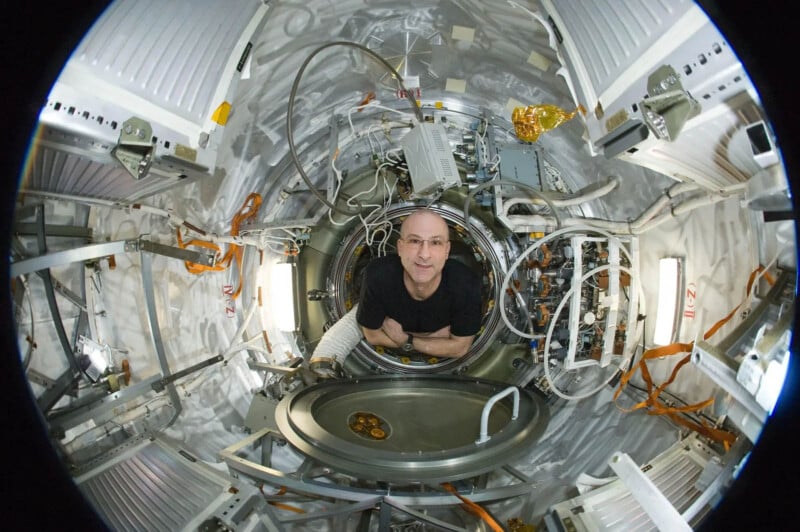 NASA astronaut Don Pettit on board the International Space Station. Photo: NASA.
NASA astronaut Don Pettit on board the International Space Station. Photo: NASA.I met Don Pettit a few years back at NASA’s Johnson Space Center in Houston with RIT colleagues and Peter. We had an inspiring afternoon touring everything space-related. The afternoon landed in Don’s garage where we quite literally talked shop.
It was exciting to take on this personal project for Don Pettit. The design requirements presented interesting challenges. The device had to rotate once every 90 min with the ability to adjust the rotational speed (+/- a few minutes) to account for variations in the orbit of the International Space Station (ISS).
The tracker had to be completely mechanical due to NASA’s rigorous testing of electronic devices. The electronic testing process takes about two years, so this was not an option to meet the launch date of September 2024. In reality, the equipment needed to be shipped to Don by January 1, 2024, so that it could be packaged and shipped up to the ISS on one of the supply missions. Of equal or greater importance, Don wanted a simple, robust device that was not subject to electronic failure.
 Early prototype – trying to determine the spacing of the parts. A spacing problem was shown here – the clock cake with a winding key, but the key could not get past the first shaft gear. The solution was to use a little gear as a thumb winder.
Early prototype – trying to determine the spacing of the parts. A spacing problem was shown here – the clock cake with a winding key, but the key could not get past the first shaft gear. The solution was to use a little gear as a thumb winder.The Design Process for the Tracker
I was not a big fan of designing a mechanical clock unless there was another option. I know that there have been numerous special clocks made over the years, and I soon zeroed in on mechanical chart recorder clock drives as a possibility. After numerous hours of searching online auctions, I found a 60-min clock drive designed for industrial ovens. This recorder scratched a record of the temperature of the oven into a metal disc.
The unit I ended up purchasing was around 40 dollars and had never been used. I did disassemble the unit to check the lubrication, and since it ran flawlessly for over a week, I decided not to change the lubrication. The unit had an operating temperature not to exceed 500° C. I know the unit was rugged, but I had no way of testing the clock to see if it would withstand the vibrations of launch, other than the clock was incredibly well built.
To convert the rotation from 60 minutes to the 90-minute rotation required, I attached a 60-tooth gear to a 90-tooth gear that would yield the desired rate of rotation. The clock recorder also came with an adjustment that satisfied the requirements of changing speeds to match different orbits of the ISS. The gears needed to be mounted between two specially designed and machined aluminum plates.
My son, Parker Kinsman, who is studying industrial design, quickly created the CAD files for a local machine shop to follow to make the plates. Since the device needed to be supported at several contact points, the two aluminum plates were covered with ¼ -20 tapped holes, which are standard for camera equipment. The plates and gears were all assembled with M4 metric threads. None of the screws were secured with Loctite due to the possible need for Don to disassemble the unit in orbit for modification or repair.
The finished tracker system was laser etched with the following information:
Rotational Coil Spring Powered Analog Star Tracker360° rotation per 90 min for ISS use.
Requested by NASA astronaut Don Pettit
Designed by Ted Kinsman, Parker Kinsman & Peter Blacksberg
December 2023
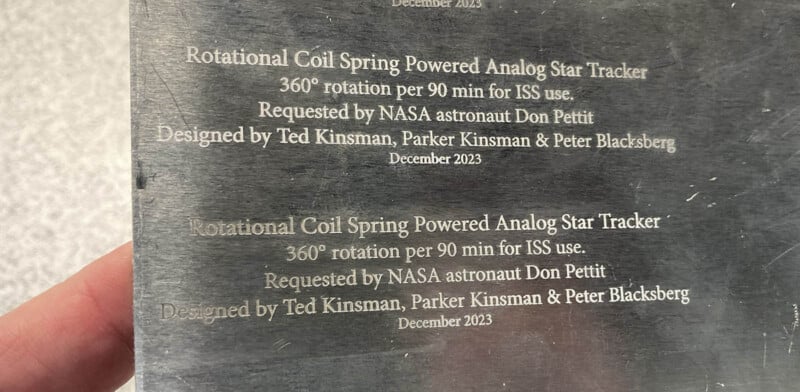 Test laser etching into scrap aluminum
Test laser etching into scrap aluminumDon is a bit of a machinist himself, so we decided to have some fun with the device name. It is quite improbable that another device will ever be built.
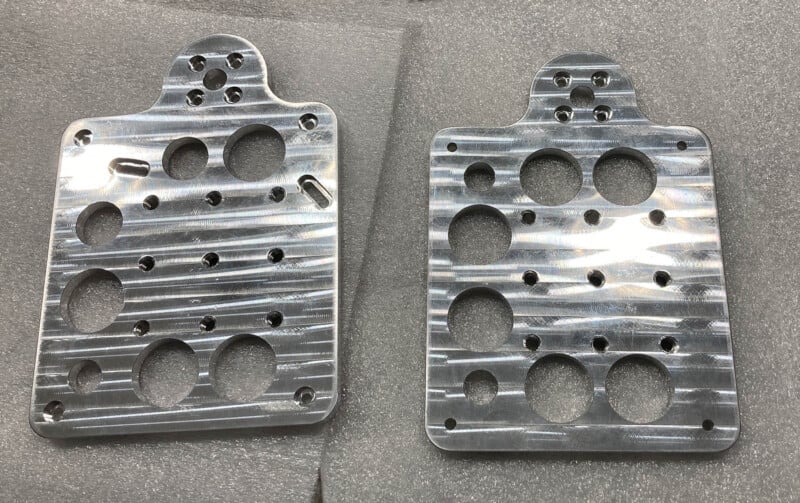 The two completed support plates fresh from the CNC machine.
The two completed support plates fresh from the CNC machine.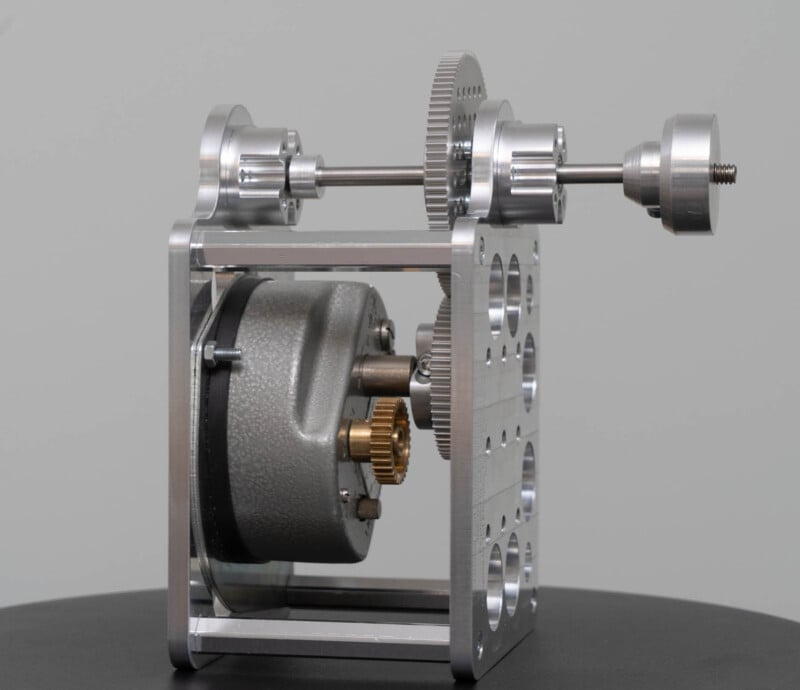 The finished star tracker. The camera is mounted on the left. Note the gold gear used to wind the mechanism’s clock. One full wind is good for 18 hours.
The finished star tracker. The camera is mounted on the left. Note the gold gear used to wind the mechanism’s clock. One full wind is good for 18 hours.The completed tracker system was delivered to Don in early January 2024 and launched up to the ISS on Aug 4, 2024. The Cygnus NG-21 rocket encountered a missed “target altitude burn” shortly after launch and I was notified that I should look into building a backup device. By the afternoon of Aug 5th, the flight engineers had come up with a slow orbital solution to get the spacecraft to the ISS. On Aug 6th the spacecraft docked at the ISS with 3,857 Kg of cargo and supplies of which 1.2Kg was the star tracking system.
With the tracker system safety aboard the ISS, the next critical flight was the arrival of Don Pettit onboard a Soyuz MS-26 spacecraft as part of Expedition 72 on September 11, 2024. Many of us watched NASA TV and breathed easier when we saw Don’s smile on the TV as he passed through the hatch onto the ISS.
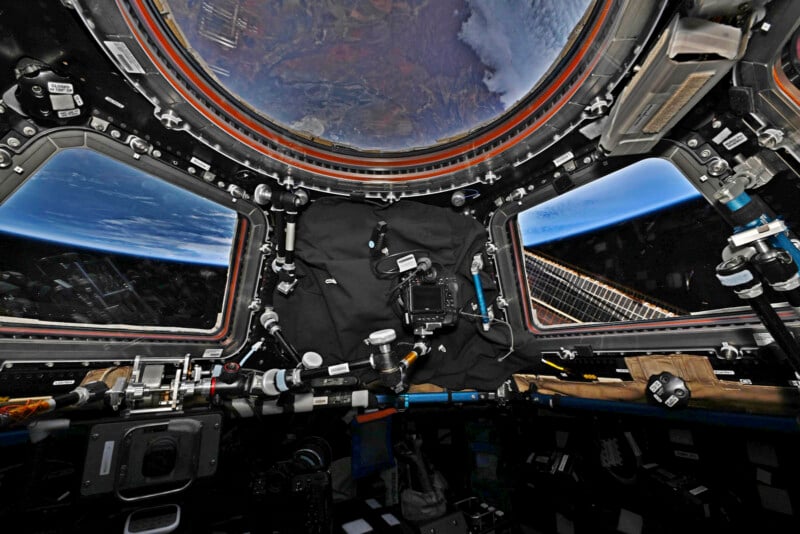 The system installed in the ISS cupola. The tracker is on the bottom left. The camera is surrounded by black-out fabric to eliminate reflections from the thick windows.
The system installed in the ISS cupola. The tracker is on the bottom left. The camera is surrounded by black-out fabric to eliminate reflections from the thick windows.NASA image by astronaut Don Pettit.
 The Star Tracker installed in the cupola. NASA image by astronaut Don Pettit.
The Star Tracker installed in the cupola. NASA image by astronaut Don Pettit.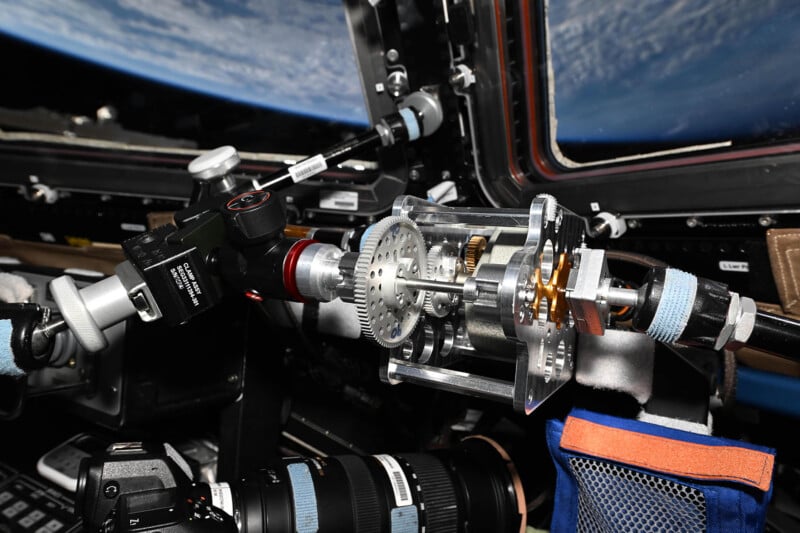 Closeup of the tracker system in position. NASA image by astronaut Don Pettit.
Closeup of the tracker system in position. NASA image by astronaut Don Pettit.One photo with: Milkyway, Zodical light, @Starlink satellites as streaks, stars as pinpoints, atmosphere on edge showing OH emission as burned umber (my favorite Crayon color), soon to rise sun, and cities at night as streaks. Taken two days ago from Dragon Crew 9 vehicle port… pic.twitter.com/iCIXwgw9JB
— Don Pettit (@astro_Pettit) January 13, 2025
Don continues to take numerous images of space as he is currently onboard the ISS. He is slated to return to Earth after his 70th birthday in the spring of 2025.
About the author: Ted Kinsman is the 2019 recipient of the Schmidt Laureate for outstanding contributions to the progress of biocommunications. Kinsman has worked as an optical engineer, a physicist, and a physics instructor before joining the Photographic Sciences Dept. at RIT. His work has appeared on The Discovery Channel, Crime Scene Investigations (CSI), The X-Files, South Park, The Tyra Banks Show, and The Frozen Planet series. Kinsman is currently an Associate Professor in the School of Photographic Arts and Sciences (SPAS) where he teaches Photographic Instrumentation, Scanning Electron Microscopy, and High-Speed Imaging.

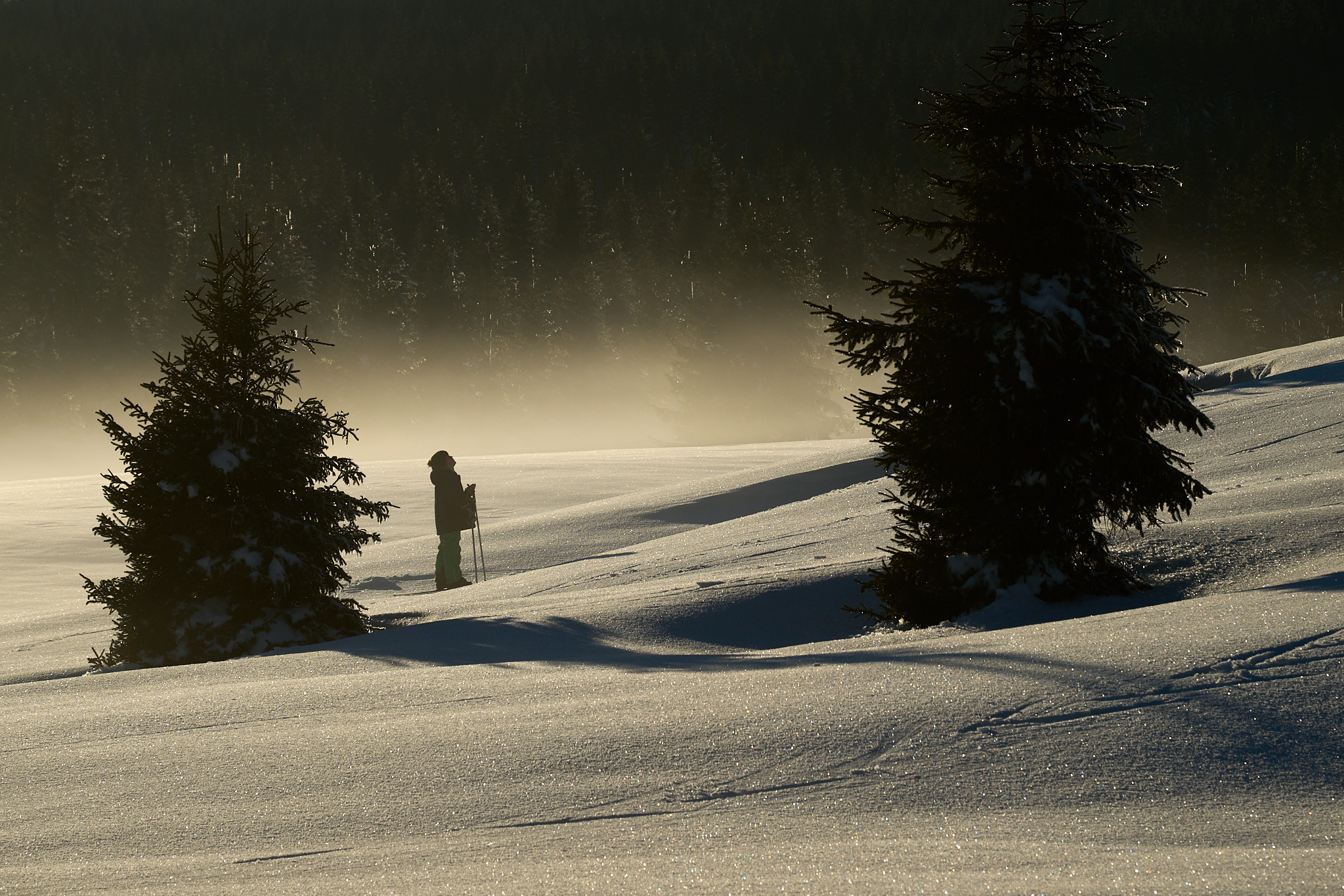





 English (US) ·
English (US) ·